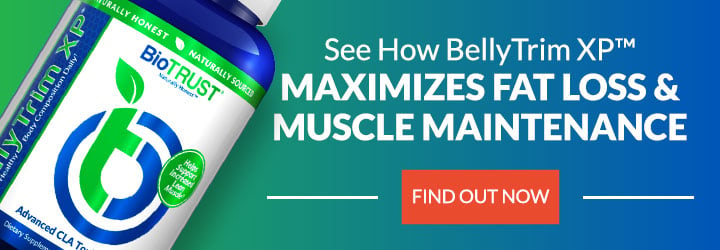Best Cardio For Weight Loss: Steady State vs High Impact

As a strength coach and personal trainer, I have often been greeted by enthusiastic clients who believe a few days of exercise each week will be the secret sauce for their weight-loss goals. And I can’t blame them. That kind of thinking is the norm—among the general population, medical professionals, and even fitness coaches.
I hate to be a Debbie Downer, but exercise by itself is a pretty futile tool for weight loss. I mean, we’re talking about maybe dropping 3 – 4 pounds over the course of a year. What’s more, there’s a strong likelihood of gaining it all back (and then some) after two years.1 That’s a pretty large investment of time and sweat with very little return. Well, at least when it comes to cardio for weight loss.
Notice I’ve highlighted “weight loss” many times. What I’m referring to here is a number on the scale. Or to be more scientifically accurate, a net change in body mass. Outside of weight loss, there are MANY, MANY health benefits associated with regular exercise. This includes what I like to call quality weight loss, which more importantly reflects changes in body composition.2,3 In other words, exercise can accelerate fat loss while helping preserve or increase lean muscle. These are changes often not captured by a number on the scale.
Having said that, regardless of whether weight loss or quality weight loss is your goal, evidence—both scientific research and real-world experience—tells us regular exercise PLUS diet are more effective than either alone.1,4 For what it’s worth, exercise by itself also seems to be quite an effective strategy for preventing weight gain and regain.
Be that as it may, as a health and fitness professional, avid exerciser, and science geek, I have ZERO hesitation insisting that structured exercise (as well as regular physical activity and movement throughout the day) is a cornerstone of a healthy lifestyle and weight-management program. And when it comes to the types of exercise that make up an effective program, I also concur with professional health organizations like the American College of Sports Medicine (ACSM) and American Diabetes Association, which suggest a combination of strength (i.e., weight training) and cardiorespiratory (i.e., “cardio”) training (not to mention flexibility and balance training).2,5
Best Cardio for Weight Loss: Steady State Cardio vs. HIIT
When it comes to cardio for weight loss, there are MANY types to choose from: walking, jogging, running, rowing, climbing, playing (sports, games, etc.), circuit training, cycling, exercise classes, and more. In addition to the type of cardio, you also have the option of choosing the frequency, duration, and intensity of your sessions. Along those lines, the topic of today’s discussion is going to revolve around intensity, which dictates duration, and to some extent, frequency.
In one corner, you have steady-state aerobic training, which is synonymous with the ol’ “slow-go” cardio that has been a mainstay of exercise guidelines since the 1960s when Dr. Kenneth Cooper literally wrote the book on Aerobics. Generally speaking, slow-go cardio—also referred to as moderate-intensity continuous training (MICT), steady-state exercise, or endurance training—consists of 30 – 45 minutes (or more) of continuous exercise.
In the other corner, you have the “new kid on the block”: High-intensity interval training, which is often called HIIT (or HIT) for short. HIIT is “characterized by brief, intermittent bursts of vigorous activity, interspersed by periods of rest or low-intensity exercise.”6 Speaking generally, HIIT workouts typically last only 10 – 20 minutes (sometimes even less), with as little as 1 minute of that time being comprised of the “bursts” of vigorous activity.
Since we know cardio should be part of a weight-management program, let’s consider some of the benefits these two heavyweights have to offer. So you can choose what’s the best cardio for weight loss and the best cardio for you.
Time Commitment
Considering that “lack of time” is one of the most commonly cited excuses barriers for not engaging in regular exercise, the time-efficient nature of HIIT gives it a clear edge. The ACSM tells us we need 150 minutes per week of “slow-go” cardio to improve health and as much as 300 minutes each week if we’re looking to lose weight. On the other hand, we can get the same health benefits from 75 minutes of HIIT weekly.2
In a recent study, a research group at McMaster University, led by HIIT authority Martin Gibala, found that a HIIT program that involved a measly 30 minutes a week (and only 1 minute of actual “work” per 10-minute session) resulted in similar health benefits (e.g., blood sugar management, insulin sensitivity) and physical adaptations (e.g., increases in mitochondria) as 150 minutes of steady-state cardio. That’s 20% of the time commitment!7
Advantage: HIIT
Effort Requirement
I’m not going to sugarcoat it: what HIIT lacks in time requirement, it more than makes up for with its effort demand. In other words, to benefit from HIIT, you have to push yourself—HARD. And if it feels easy, it’s time to make it harder.
Of course, both HIIT and slow-go cardio require a certain degree of mental toughness. For instance, your capacity to perform 30 – 45 minutes (heck, even HOURS) of steady-state exercise is not by physical limitations. Rather, for most people, it comes down to mental effort. And when it comes to HIIT, it can be quite a challenge to repeatedly muster the mental fortitude needed to put forth the necessary physical effort.
Advantage: slow-go cardio
Level of Fitness Requirement
When it comes to level of requirement as far as the best cardio for weight loss, you may think the obvious answer here is slow-go cardio. Indeed, some have argued that HIIT-style exercise is “inappropriate for a largely sedentary population” as it’s so strenuous.8 While this seems intuitive, many HIIT studies have been successfully completed with sedentary people showing quite clearly that HIIT is a viable option. Of course, if you’re not currently exercising, then you’ll want to get your doctor’s okay. You may also consider hiring a personal trainer to help you with a program that’s appropriate for your level of fitness and exercise experience.
Advantage: No Advantage
Health Benefits
The health, respiratory, and metabolic benefits of regular cardio are numerous and varied. And the great news is that there seems to be very little difference between slow-go cardio and HIIT. In other words, as long as you’re doing enough of either or both, you should reap similar health rewards.
Advantage: No Advantage
Metabolism Benefits
One of the most highly touted benefits of HIIT is that it boosts the metabolism for hours after exercise. This is, in fact, true. (It’s a physical phenomenon referred to as excess post-exercise oxygen consumption, or EPOC for short.) Yet I tend to think this effect (often called “the afterburn”) is overstated—sometimes drastically so.
HIIT does indeed result in an increase in EPOC—which is linearly related to exercise intensity. (That is, the higher the intensity, the greater the EPOC). Yet when you factor in the number of calories burned during and after a cardio session, there’s really no difference between HIIT and slow-go cardio. Surprised? If anything, slow-go cardio burns more calories. According to one comprehensive study on EPOC, the major impact of exercise on body weight occurs as a result of the amount of energy burned during the actual exercise.9–12
Advantage: Slight edge to slow-go cardio
Weight-Management Benefits
Exercise is a particularly effective tool for: 1. Improving body composition; 2. Preventing weight gain; and 3. Promoting weight maintenance. However, as I pointed out at the onset, exercise—at least by itself—is a pretty futile tool for weight loss. You don’t have to take my word for it.
In a recent review and meta-analysis (which is a very high-level analysis of all the studies published on a specific topic) published in the journal Obesity Reviews, researchers from the Department of Exercise Physiology at the University of New South Wales in Australia compared the effects of HIIT and MICT on weight loss and body composition. After scouring through over 1,300 articles, they concluded that BOTH “moderate-intensity to high-intensity exercise training can induce modest body composition improvements in overweight and obese individuals without accompanying body-weight changes.”13
In other words, they found both MICT and HIIT reduced waist circumference and body fat independent of changes on the scale. Another interesting finding: HIIT led to similar improvements but required about 40% less training time commitment.
Having said that, some studies have suggested HIIT may hold a slight edge when it comes to fat loss. For instance, one of the first studies shining light on HIIT found that 15 weeks of HIIT resulted in significantly greater fat loss than 20 weeks of endurance training. When the researchers compared “apples to apples” by correcting for the energy cost of exercise, they concluded that the HIIT program resulted in NINE TIMES more fat loss.14
In another study published in The International Journal of Obesity, researchers found that 20-minute HIIT performed three times per week for 15 weeks resulted in significantly greater reductions in body and abdominal fat than the same frequency of steady-state exercise.15 Additional studies have shown HIIT may be particular effective for reducing abdominal fat. And HIIT may have its most pronounced fat-loss effects in overweight and obese folks.9
HIIT typically burns fewer calories during exercise, and it’s unlikely that “the afterburn” is as pronounced as some would lead you to believe. So what gives? Well, it’s possible that HIIT may have a stronger appetite-suppressing effect than steady-state cardio. This, in turn, may result in reduced caloric intake. Along these lines, there’s some evidence that high-intensity exercise can reduce levels of the hunger hormone ghrelin to a greater extent than moderate-intensity exercise.16
Advantage: HIIT
Adherence Advantage
Simply put, if you can’t stick to the requirements of an exercise program, you can’t reap the benefits. While it may seem like the scales are tipped in favor of HIIT, you might think that program adherence is lower because: 1. It’s hard; and 2. It could lead to injury.
With regard to the latter, based on personal experience, I’d contend that slow-go cardio is likely to lead to more (overuse) injuries in the long-run. Generally speaking, studies show that HIIT-based programs have just as high of a rate of compliance (if not higher) as steady-state exercise. And that’s regardless of fitness level.17
Having said that, there is some evidence that HIIT protocols are less enjoyable, especially over time.18 I have personally observed this with many clients. They have difficulty getting motivated to push themselves to the extent HIIT requires. Conversely, I know many folks like me experience nausea at the thought of a 30 – 45-minute cardio session. Not. Gonna. Happen. Multiple studies have also shown that folks prefer HIIT and find it more enjoyable than steady-state cardio.19,20 So, it seems like it’s a bit of a toss-up. In other words, the best cardio for weight loss in reference to adherence comes down to personal preference.
Advantage: Personal Preference
And the Winner Is…
While it may seem like the obvious winner is HIIT, the real answer is that it depends on personal preference. After all, the best cardio for weight loss is the one you will use the most.
While I’d personally much rather invest more effort and less time, that just doesn’t float everyone’s boat. Regardless of what you choose, progression is the name of the game. Yep, you have to continue to push yourself.
Having said that, I’ll tell you MY personal preference: BOTH. I think there’s tremendous value in being able to perform at multiple levels of intensity. And even though the health benefits are quite similar, the performance benefits are a bit more specific.
Now, if I personally chose the best cardio for weight loss, it would be HIIT. However, there are indeed instances where slow-go cardio is ideal, particularly if you’re the type of person who’s stressed out and/or already doing a lot of high-intensity exercise.








